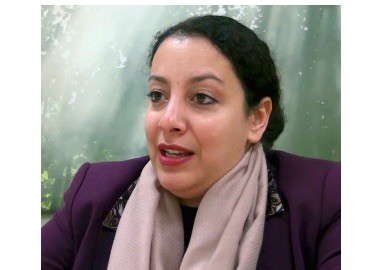. . WOMEN’S EQUALITY . .
An article from Nobel Women’s Initiative
Human rights activist. Rasha Jarhum is a Yemeni activist currently based in Geneva. She is a founder of the Peace Track Initiative, established to create a space for the contributions of women, youth and civil society organizations to peace processes.

Your mother, Hooria Mashhour, is a longtime activist; after the 2011 uprising in Yemen, she became the country’s first Human Rights Minister. Is it fair to say that you were raised in the struggle?
My mother was a fierce advocate for women’s rights. She served in the Women National Committee for almost a decade, and after the uprising began was the first government official to quit her position in protest of the vicious force used against peaceful protesters. Later, she was selected as spokesperson of the revolution forces council – the first time in Yemeni history that a woman spoke for a political movement. I was privileged to have her as my mentor. Since I was a child, I joined her in workshops and campaigns – she is the reason I became an activist. We have our political disagreements, and I love that she has never tried to pressure me to change my position.
You also learned from your mother that activism can be costly.
That’s something my whole family understands. My husband’s father, who was the first to sue Yemen’s former president Ali Abdullah Saleh for embezzling state money, was assassinated. In the current war, which began in 2014, we lost family members and property and were threatened and followed. My mother’s name was put on a list of wanted infidels, and armed men appeared at her office. She left to seek political asylum in Germany.
Why did you also leave Yemen?
After the 2011 uprising, when President Saleh stepped down, I believed that we would be able to build a modern civil state in Yemen. As part of the UN, I worked on a programme to mobilize people, including women, to vote. I wanted to make Yemenis taste the future of democracy.
But I’d lived through two devastating earlier wars, in 1986 in South Yemen and the 1994 war between North and South, and I had two young sons. During the uprising, we witnessed armed conflict in Sana’a, and out of fear for our children that the conflict would escalate, my husband and I began seeking opportunities outside the country. In 2012, he got a job offer in Lebanon, and we went to Beirut for five years. From there, I continued to support civil society organizations remotely, and worked with Oxfam on the Syrian Refugee Crisis and Gender Justice Programme. When the 2014 war in Yemen began, I knew it would be long and ugly.
(Article continued in right column)
Do women have a special role to play in the peace movement?
(Article continued from left column)
What’s the purpose of the Peace Track Initiative?
The Initiative works towards localizing peace processes and insuring inclusiveness, with an underlying premise that those directly affected by war are those with the greatest stake in peacebuilding. It has two components: one that focuses on Yemen, and the other on the whole Middle East and North Africa region. In Yemen, I support women-led organizations at the community level and women’s groups in peacebuilding activities. So much of what these women do is invisible to the world.
What are local women doing in promote peace in Yemen? Why doesn’t the international community hear more about it?
Historically, the situation for women in Yemen was bad. Women had no freedom to go to work, travel, even get married. Legislative, institutional and societal norms all hindered women. But women led the revolution in 2011, and today, Yemeni women are again on the frontlines. In besieged areas, women walk for miles to bring lifesaving items to their families, mobilize relief convoys, smuggle medicine to hospitals. It is estimated that one-third of fighters in Yemen are children, and women are addressing the issue of child recruitment. Women are working on complicated issues such as releasing detainees, combating terrorism through social cohesion work and the de-radicalization of youth. Women are working to revive the economy through collective saving groups, farming and social entrepreneurship.
When women are involved in peace processes, we focus on responsibility-sharing rather than power-sharing. The participation of women in national dialogue in 2011 led to the creation of one of the strongest rights and freedom’s packages in Yemeni history.
But the humanitarian agencies working in Yemen portray women only as passive victims. The stories of their resilience and their leadership do not get reported. Part of the problem is that local women may be working as individuals or in coalitions that are not formally registered, and thus deprived of funding opportunities. In addition, many Yemeni women do not speak English.
On December 4, former president Saleh was killed, and the situation in Yemen seems to have grown even worse.
For years, Yemen was the worst country for women to live in. With this war, our humanitarian crisis increased. We now have a million pregnant women at risk of malnutrition and around two million women and girls at risk of gender-based violence, including rape.
But when you hit rock bottom, there is only one way to move: up. I believe that a real, sustainable and inclusive peace can be achieved in Yemen. And I think the solution is really in the hands of women.
(Thank you to Janet Hudgins, the CPNN reporter for this article)